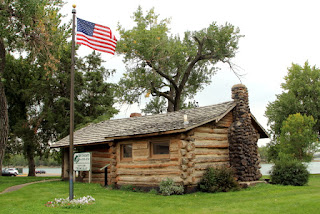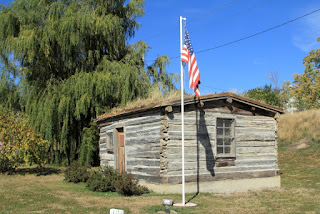Pierre is now the second least-populous state capital in the United States, but when I was growing up it seemed like a major metropolitan City. There were two movie theaters and in later years a drive-in theater was open during the summer months. Of course, during the summer it does not get dark until about 10 PM, so there were no early shows at the drive-in!
In 2015, to honor the Monopoly game's 80th birthday, Hasboro (the company that makes and sells the Monopoly game) held an online vote to determine which cities would be on the "Here and Now: The US Edition" of the game board. The top "Boardwalk" spot went to Pierre (Yes, PIERRE!), beating out cities like New York, Los Angeles, Chicago, Boston, etc. Of course, Pierre had a little help from the picture that they submitted - Mount Rushmore! Mount Rushmore is only 150 miles to the west, but in South Dakota that's just considered to be a short drive.
One day when I was in town I decided to drive around to see some of the places that I remembered from when I was growing up. I started at St. Mary's Hospital where I was born and then went by the County Courthouse.
A short distance from the Courthouse is the church that I attended. Governor Joe Foss, who had been the leading Marine fighter ace in World War II, was my Sunday school teacher, so all of the boys in the class always wanted him to tell war stories rather than teach a Sunday School Lesson. Governor Foss later went on to become the first commissioner of the American Football League and a television broadcaster.
While I was in Junior High School, a new High School building was completed and our class was the first class to complete all three years at the new building. However, the campus has changed so much that it was difficult to visualize what the original structure actually looked like. (None of the building in the picture existed when I graduated.)
The historic Pierre Power Plant is now a museum, but this is where we would get our drinking water for the farm. We had a 1,000 gallon tank that would fit in the box of a two-ton, single axle truck to haul the water from the power plant to a cistern located on the west side of the farm house.
Unfortunately, there were two problems with this arrangement. First, in the winter the water that spilled when filling the tank would freeze in the truck box and the tank would slide around if not securely fastened, which it typically wasn't; and then it was difficult to empty the tank when arriving at the farm. And, second, the cistern seal was not very tight; so we often found frogs and snakes in the water. When the water smelled so bad that you had a hard time drinking it, you knew it was time to clean the cistern. This was accomplished by climbing down a ladder (the ladder was then removed) and someone on top would lower a bucket tied to a rope while the person in the cistern cleaned up all of the mess and put it in the bucket. Not a fun job!
It was always fun to visit the capital building and the nearby museums when I was in grade school. I remember that the first place that the boys always wanted to go in the museum was to the War section and see the human skull that had an Indian arrowhead stuck in the eye socket. (Seems kind of gross now!)
Capitol Lake (located just east of the Capitol Building) has always been an attraction and is home to a number of different bird species. The lake is fed by an artesian spring that also emits methane gas; so it was not unusual on special occasions for high school students to light the lake on fire (Not me, of course!). After I moved away, several memorials were built along the lake's edge and the methane gas was piped into a cauldran for an eternal flame. (All of the below-pictures are from my file, taken at different times.)
Pierre's first school house was a one-room 14 X 20 foot wooden building that was built in 1881 and is now located in Steamboat Park. Also located just down the street is the Girl Scout's Town Cabin "Tichicala" that was constructed in 1890. The cabin was acquired by the City and then donated to the Girl Scouts in 1929. The Girl Scouts named the structure "Tichicala," which means "little house." The Girl Scouts still use the building.
The South Dakota State Historical Society Cultural Heritage Center opened after I moved away from Pierre, but I have visited it and driven by it on different occasions. The main attraction is the Verendrye Plate that was discovered on a hill in Fort Pierre on February 16, 1913; but there are also several other exhibits of historical significance. (All of the following pictures are from my file - I did not tour the Museum on this trip.)
 |
| Verendrye Plate |
Located in front of the Center is a statue entitled Citadel, which is dedicated to the "pioneer women of South Dakota." At the base of the statue is a plaque that contains a quote from John Steinbeck's The Grapes of Wrath: "She seemed to know, to accept, to welcome her position, the citadel of the family, the strong place that could not be taken. ...she had dignity and a clean calm beauty. ...as a healer, her hands had grown sure and cool and quiet:...as arbiter she had become as remote and faultless in judgment as a goddess."
Also located in front of the Center is one of the Quartzite Border Markers that was used to divide South and North Dakota. 720 quartzite stones were purchased from North Sioux Falls Stone Company and placed every 1/2 mile along the line between the two states. The boundary became known as the "quartzite border" and it is the only state boundary marked in this fashion.
For those people that like to shop, Pierre has the World's Largest Menards store.
If shopping is not your thing, you can always go to the world famous Zesto for ice cream. People actually come from all over just to get their famous ice cream specials.
 |
| File Picture |
 |
| File Picture |
After stuffing yourself with ice cream, you can then go down to the Missouri River for some water sports.
 |
| File Picture |
The Lewis and Clark Corps of Discovery camped on the south side of the mouth of the Bad River on September 23-28, 1804. During their encampment at this location they had the first historic meeting of officials from the Unites States of America and leaders from the great Sioux Nation. After much feasting and celebrating, an armed confrontation between the two groups broke out, but the confrontation was reportedly diffused largely though the efforts of Chief Black Buffalo.
Fort Pierre Chouteau was established in 1832 as a trading post and fort by St. Louis industrial fur trader Pierre Chouteau, Jr. The Fort was located about a mile north of the confluence of the Missouri and Bad Rivers and replaced Fort Tecumseh, which was established in 1822. Today a monument and various interpretive signs have been placed at the fort site.
The historic Old Deadwood Trail started where the current traffic bridge crosses the Missouri River. It was from this point that steamships coming up the Missouri River were unloaded and the freight placed on ox-drawn wagons for the 200 mile trip to Deadwood. The round trip took 30 days.
Then, in 1876 the Northwestern Railway started operating "The Bull Train," which made the round trip from Fort Pierre to Deadwood in 15 days by using 20-ox teams pulling three wagons that contained 20,000 pounds of freight. The ox-teams traveled from 4 AM to 10 AM, rested for six hours and then traveled from 4 PM until dark each day.
The Fort Pierre Railroad Depot was constructed in 1906 in anticipation of completion of a railroad bridge across the Missouri River from Pierre to Fort Pierre in 1907. During this same time period, The Chicago and Northwestern quickly laid railroad tracks from Fort Pierre to Rapid City.
In 1964 the railroad was abandoned and the depot was sold to a rancher in Mud Butte (about 170 miles northwest of Fort Pierre) to be used as a storage shed, a sheep shearing facility, and a wool storage area. Several years ago, the depot was discovered by an insurance adjuster and, after some negotiations, the rancher donated the building to the Verendrye Museum. The building is now back in Fort Pierre.
Cedar Hill Cemetery is located on a hill overlooking Fort Pierre and the Missouri River. Cedar Hill is "the final resting place of some colorful local personalities including outlaws, fur traders, military veterans of Civil War, WWI, and WWII, prospectors, Native American residents, suffragettes, murder victims, and a great many children who succumbed to multiple epidemics, and historic leaders."
The most famous person that was born and raised in the Fort Pierre area was Casey Tibbs - At 19 years-of-age Casey became the youngest man to ever win the National Saddle Bronc-Riding Crown. Between 1949 and 1955 Casey won a total of six PRCA Saddle Bronc-Riding Championships, plus two All-Around Cowboy Championships, and one Bareback-Riding Championship. His record is still unchallenged today.
Casey was always friendly to kids at the rodeos and I can remember meeting him several times when I was in grade school. I even had a purple cowboy shirt with white stripes that was like Casey's, except my shirt was better than Casey's because my Mother made it for me. She even used pearl white snaps on the shirt rather than buttons. That was my favorite shirt of all times and I wore it until it disintegrated.
In later years Casey moved to Hollywood and performed in several movies. He did all of the rodeo scenes for Steve McQueen in the 1972 movie Junior Bonner, and was good friends with John Wayne and often game him advice on how to produce realistic western films.
The Casey Tibbs Rodeo Center Museum & Mattie Goff Newcombe Conference Center is located on a hill overlooking Fort Pierre and the Missouri River.
Although Mattie was not from Fort Pierre, she was born in Western South Dakota and was famous for her bronc-riding and rodeo trick ridding. She earned the All-Around Cowgirl and World Champion Trick Rider honors many times during her career.















































































